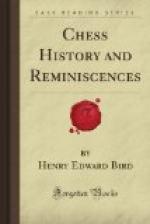Zukertort was undoubtedly a far more ready, and we have long thought a finer player than Steinitz, but skill was so nicely balanced between them that a very slight variation or acceleration in rate would have been in Zukertort’s favour. At 25 moves an hour or at any faster rate it would have been odds on Zukertort, at 15 moves an hour or less it would have been safer to back Steinitz. Staunton, Kolisch, and Paulsen seem to have been the slowest of the players, 10 moves an hour would suit them better than 15, a 10 or 12 hour game with them was not uncommon. Bird is the fastest, and his best games have averaged 40 moves an hour or two or three hours for a game, a reasonable rate for recreationary chess.
In the last century one-and-a-half or two hours was considered a fair duration for a good game, 30 moves an hour would give three hours for a game of 45 moves or four for a game of 60 moves, and such could be finished at the usual sitting without adjournment.
The period dating from the France and England Championship Match between St. Amant and Staunton in 1843, to the Vienna Tournament of 1873, was singularly prolific in very great chess players. In addition to Anderssen 1851, and Morphy 1858, there appeared in the metropolis in 1862 Louis Paulsen, William Steinitz, and J. H. Blackburne, three players who, as well as Captain Mackenzie competed in the British Chess Association’s Tournaments of that year, and were destined with Zukertort and Gunsberg of ten years later growth, to rank as conspicuously successful among even the score or so of the pre-eminently distinguished players of the highest class the world has ever produced, the Rev. G. A. MacDonnel1 and Barnes were of five and Boden of 12 years earlier reputation, all were competing in the 1862 contest, Buckle died in this year, and his opponent Bird had retired from chess, other pursuits entirely absorbing his time mostly abroad. He had been the hardest fighter and most active of the English combatants of 15 years before, and it was his fate about four years later, once more to become not the least prominent and interesting of the leading chess players.
Chess as now played with the Queen of present powers, imported into the game dates back about four centuries, to near the time when the works of the Spanish writers, Vicenz and Lucena, appeared in 1495, and shortly before that of Damiano the Portuguese in 1512. In 1561 Ruy Lopez, the Spanish priest of Cafra, a name familiar to the present generation, from one of the openings most approved in modern practice being named after him, wrote the best work of a scientific character which had appeared in Europe to that time, and he was considered in Spain the very best player in the world, until the memorable contests between him and Leonardo da Cutri, and Paolo Boi of Syracuse left the question of supremacy doubtful. These famous struggles are reverted to not without interest in our days, when the not very profitable task of attempting




